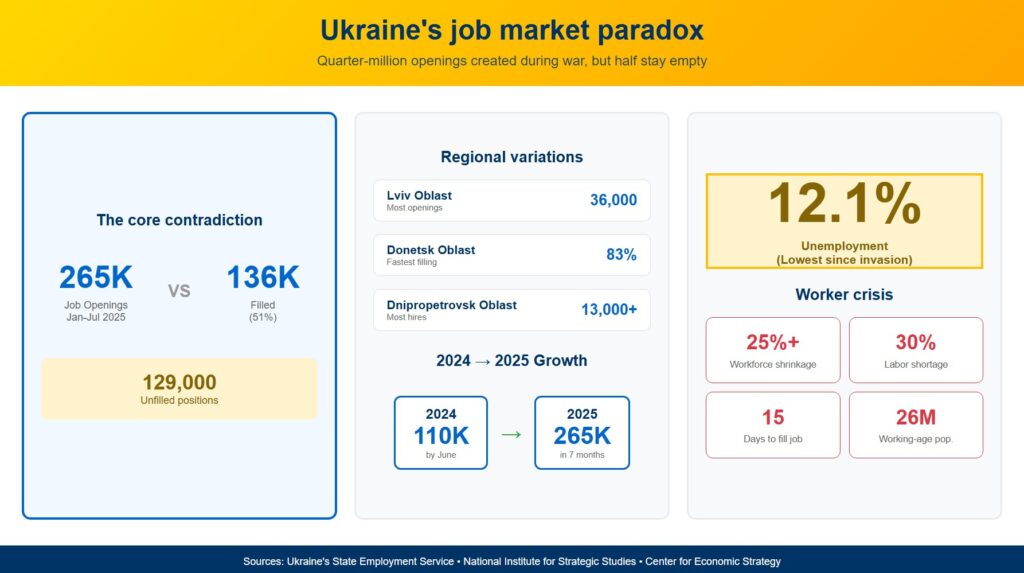Ukraine posts 265,000 jobs during war but half the workers are gone

Ukraine’s State Employment Service reported 265,000 new job openings in the first seven months of 2025, yet could only fill 136,000. This paradox captures the country’s economic transformation: resilient enough to create work, too demographically hollowed out to do it.
The 15-day average time to fill positions might sound reasonable anywhere else. But in a country losing workers to mobilization, migration, and missiles, every unfilled vacancy represents capacity Ukraine can’t afford to waste. Half the jobs posted remain empty—not from lack of demand, but from lack of people.
From economic collapse to hiring boom
The trajectory shows Ukraine’s remarkable economic recovery. According to the National Institute for Strategic Studies, Ukraine’s first half of 2024 saw just 110,000 vacancies by June. The 2025 total of 265,000 in seven months represents more than double the pace—a hiring boom that coincided with unemployment dropping from chaotic 13-20% swings in 2024 to a stable 12.1% in April 2025, the lowest since Russia’s invasion began.
But the boom has peaked.
New vacancy postings have practically stopped growing and remain at just 85-90% of 2021 levels. Job search activity reaches only 80% of pre-war averages, even as people search more actively than in 2024.
Ukraine’s economy wants to hire faster than before the war, but it just cannot find the workers.
Where the workers went
The numbers reveal the scale of Ukraine’s demographic crisis. The workforce aged 15-70 shrank by over a quarter compared to pre-war 2021 levels. Almost half that decline came from external migrants who don’t work remotely, while mobilization and displacement account for the rest. The Ministry of Economy estimated the overall labor shortage nearly 30% a year ago.
Ukraine now has only 26 million people aged 15 and older, from a population of just 31 million. “Even if the war ends next year, by 2032 Ukraine will have only about 30 million people,” warns Hlib Vyshlinsky, director of the Centre for Economic Strategy.
That means just 13 million economically active citizens and 10 million inactive, mostly pensioners.
The mismatched millions
The unemployment paradox reveals structural dysfunction beneath the statistics. With 12.1% unemployment alongside desperate labor shortages, the problem isn’t lack of workers — it’s workers in the wrong places with the wrong skills.
Ukraine’s 2.1 million internally displaced persons represent the clearest missed opportunity.
Despite the desperate need for workers, only 800,000 internal refugees had official employment as of April 2024. According to the National Institute for Strategic Studies, barriers include psychological trauma, qualification mismatches with local labor markets, difficult access to childcare services, and bureaucratic obstacles that job applicants encounter.
Regional patterns tell the same story of disconnection. Lviv Oblast generated the most openings — 13.4% of all vacancies, nearly 36,000 positions — as businesses and people fled westward from the fighting.
Meanwhile, the frontline Donetsk Oblast filled 83% of its job postings within just seven days, reflecting desperate circumstances where people near the front take whatever work they can find.
Dnipropetrovsk Oblast managed the most successful placements, with over 13,000 people hired. This reflects the region’s longstanding industrial base, which is now struggling to maintain operations under regular bombardment and severe worker shortages.
What this means for business
The employment data show both opportunities and constraints for companies considering Ukrainian operations. Ukraine generates strong demand for workers—sales consultants and managers top hiring lists, followed by medical workers, teachers, and industrial positions. The country is building and buying, not just surviving.
However, labor availability varies significantly by region. Western regions, like Lviv Oblast, offer larger candidate pools but face intense employer competition. Eastern regions show faster hiring but operate under security constraints. Skilled positions consistently take longer to fill than basic roles.
Ukraine’s job market paradox—too much work, too few workers—captures its broader challenge: proving it can function during crisis while facing a demographic cliff that threatens its post-war viability.
The economy shows resilience, but the population numbers show limits no amount of resilience can overcome.